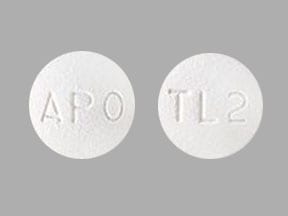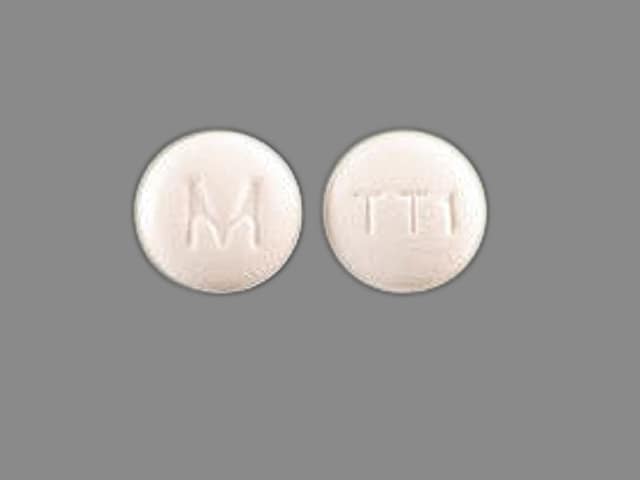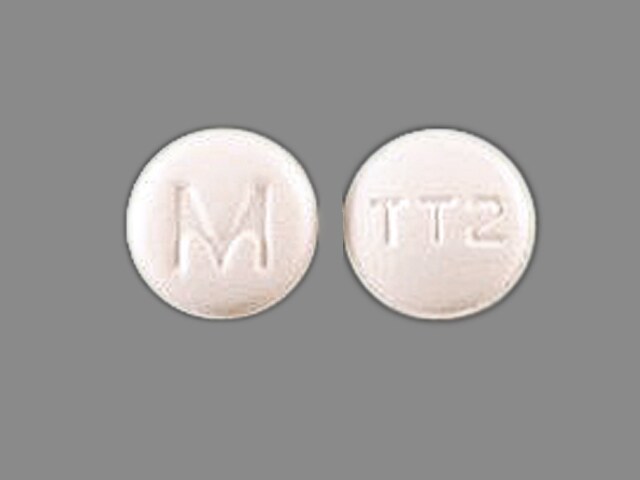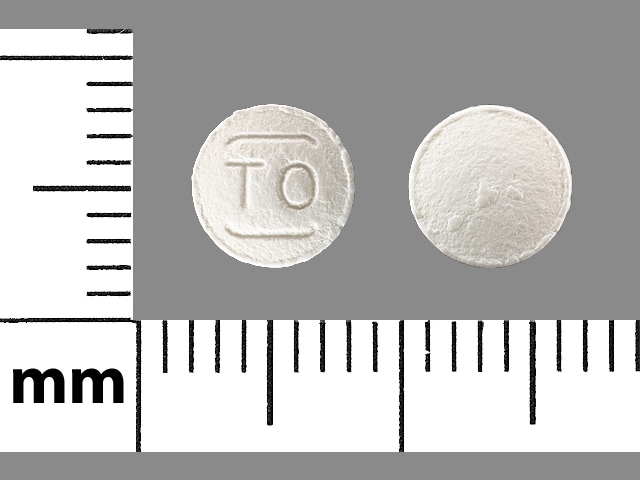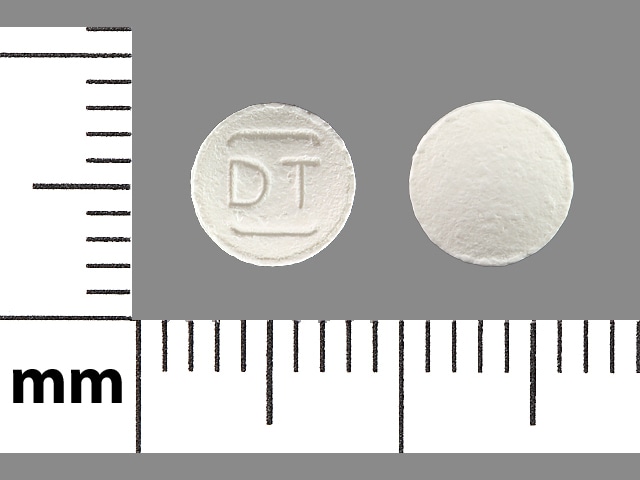Dosage Forms
Excipient information presented when available (limited, particularly for generics); consult specific product labeling.
Capsule Extended Release 24 Hour, Oral, as tartrate:
Detrol LA: 2 mg, 4 mg
Generic: 2 mg, 4 mg
Tablet, Oral, as tartrate:
Detrol: 1 mg, 2 mg
Generic: 1 mg, 2 mg
Pharmacology
Mechanism of Action
Tolterodine is a competitive antagonist of muscarinic receptors. In animal models, tolterodine demonstrates selectivity for urinary bladder receptors over salivary receptors. Urinary bladder contraction is mediated by muscarinic receptors. Tolterodine increases residual urine volume and decreases detrusor muscle pressure.
Pharmacokinetics/Pharmacodynamics
Absorption
Immediate release tablet: Rapid; ≥77%
Distribution
IV: Vd: 113 ± 27 L
Metabolism
Extensively hepatic, primarily via CYP2D6 to 5-hydroxymethyltolterodine (active) and 3A4 usually (minor pathway). In patients with a genetic deficiency of CYP2D6, metabolism via 3A4 predominates.
Excretion
Urine (77%); feces (17%); primarily as metabolites (<1% unchanged drug) of which the active 5-hydroxymethyl metabolite accounts for 5% to 14% (<1% in poor metabolizers); as unchanged drug (<1%; <2.5% in poor metabolizers)
Time to Peak
Immediate release tablet: 1-2 hours; Extended release capsule: 2-6 hours
Half-Life Elimination
Immediate release tablet: Extensive metabolizers: ~2 hours; Poor metabolizers: ~10 hours
Extended release capsule: Extensive metabolizers: ~7 hours; Poor metabolizers: ~18 hours
Protein Binding
>96% (primarily to alpha1-acid glycoprotein)
Use in Specific Populations
Special Populations: Renal Function Impairment
In patients with CrCl 10 to 30 mL/min, immediate-release tolterodine and metabolite levels were 2- to 3-fold higher compared with healthy patients. ER tolterodine has not been studied in patients with CrCl less than 10 mL/min.
Special Populations: Hepatic Function Impairment
The elimination half-life of immediate-release tolterodine was longer and Cl was substantially lower in cirrhotic patients compared with healthy patients.
Special Populations: Elderly
Serum concentrations of immediate-release tolterodine and 5-HMT were 20% to 50% higher in elderly patients.
Use: Labeled Indications
Treatment of patients with an overactive bladder with symptoms of urge urinary incontinence, urgency, or frequency
Contraindications
Hypersensitivity to tolterodine or fesoterodine (both are metabolized to 5-hydroxymethyl tolterodine) or any component of the formulation; urinary retention; gastric retention; uncontrolled narrow-angle glaucoma
Dosage and Administration
Dosing: Adult
Treatment of overactive bladder: Oral:
Immediate release tablet: 2 mg twice daily; the dose may be lowered to 1 mg twice daily based on individual response and tolerability
Dosing adjustment in patients concurrently taking strong CYP3A4 inhibitors (eg, ketoconazole, clarithromycin, ritonavir): 1 mg twice daily
Extended release capsule: 4 mg once daily; dose may be lowered to 2 mg once daily based on individual response and tolerability
Dosing adjustment in patients concurrently taking strong CYP3A4 inhibitors (eg, ketoconazole, clarithromycin, ritonavir): 2 mg once daily
Administration
Extended release capsule: Swallow whole; do not crush, chew, or open
Storage
Store at 25°C (77°F); excursions permitted to 15°C to 30°C (59°F to 86°F). Protect from light.
Tolterodine Images
Drug Interactions
Abiraterone Acetate: May increase the serum concentration of CYP2D6 Substrates (High risk with Inhibitors). Management: Avoid concurrent use of abiraterone with CYP2D6 substrates that have a narrow therapeutic index whenever possible. When concurrent use is not avoidable, monitor patients closely for signs/symptoms of toxicity. Consider therapy modification
Acetylcholinesterase Inhibitors: May diminish the therapeutic effect of Anticholinergic Agents. Anticholinergic Agents may diminish the therapeutic effect of Acetylcholinesterase Inhibitors. Monitor therapy
Aclidinium: May enhance the anticholinergic effect of Anticholinergic Agents. Avoid combination
Ajmaline: May increase the serum concentration of CYP2D6 Substrates (High risk with Inhibitors). Monitor therapy
Amantadine: May enhance the anticholinergic effect of Anticholinergic Agents. Monitor therapy
Anticholinergic Agents: May enhance the adverse/toxic effect of other Anticholinergic Agents. Monitor therapy
Aprepitant: May increase the serum concentration of CYP3A4 Substrates (High risk with Inhibitors). Monitor therapy
Asunaprevir: May increase the serum concentration of CYP2D6 Substrates (High risk with Inhibitors). Consider therapy modification
Bosentan: May decrease the serum concentration of CYP3A4 Substrates (High risk with Inducers). Monitor therapy
Botulinum Toxin-Containing Products: May enhance the anticholinergic effect of Anticholinergic Agents. Monitor therapy
Cannabinoid-Containing Products: Anticholinergic Agents may enhance the tachycardic effect of Cannabinoid-Containing Products. Exceptions: Cannabidiol. Monitor therapy
Chloral Betaine: May enhance the adverse/toxic effect of Anticholinergic Agents. Monitor therapy
Cimetropium: Anticholinergic Agents may enhance the anticholinergic effect of Cimetropium. Avoid combination
CloBAZam: May increase the serum concentration of CYP2D6 Substrates (High risk with Inhibitors). Monitor therapy
Clofazimine: May increase the serum concentration of CYP3A4 Substrates (High risk with Inhibitors). Monitor therapy
Conivaptan: May increase the serum concentration of CYP3A4 Substrates (High risk with Inhibitors). Avoid combination
CYP2D6 Inhibitors (Moderate): May decrease the metabolism of CYP2D6 Substrates (High risk with Inhibitors). Monitor therapy
CYP2D6 Inhibitors (Strong): May decrease the metabolism of CYP2D6 Substrates (High risk with Inhibitors). Consider therapy modification
CYP3A4 Inducers (Moderate): May decrease the serum concentration of CYP3A4 Substrates (High risk with Inducers). Monitor therapy
CYP3A4 Inducers (Strong): May increase the metabolism of CYP3A4 Substrates (High risk with Inducers). Management: Consider an alternative for one of the interacting drugs. Some combinations may be specifically contraindicated. Consult appropriate manufacturer labeling. Consider therapy modification
CYP3A4 Inhibitors (Moderate): May decrease the metabolism of CYP3A4 Substrates (High risk with Inhibitors). Monitor therapy
CYP3A4 Inhibitors (Strong): May increase the serum concentration of Tolterodine. Management: The maximum recommended adult dose of tolterodine is 2 mg/day when used together with a strong CYP3A4 inhibitor. Consider therapy modification
Dabrafenib: May decrease the serum concentration of CYP3A4 Substrates (High risk with Inducers). Management: Seek alternatives to the CYP3A4 substrate when possible. If concomitant therapy cannot be avoided, monitor clinical effects of the substrate closely (particularly therapeutic effects). Consider therapy modification
Dacomitinib: May increase the serum concentration of CYP2D6 Substrates (High risk with Inhibitors). Management: Avoid concurrent use of dacomitinib with CYP2D6 subtrates that have a narrow therapeutic index. Consider therapy modification
Deferasirox: May decrease the serum concentration of CYP3A4 Substrates (High risk with Inducers). Monitor therapy
Duvelisib: May increase the serum concentration of CYP3A4 Substrates (High risk with Inhibitors). Monitor therapy
Eluxadoline: Anticholinergic Agents may enhance the constipating effect of Eluxadoline. Avoid combination
Enzalutamide: May decrease the serum concentration of CYP3A4 Substrates (High risk with Inducers). Management: Concurrent use of enzalutamide with CYP3A4 substrates that have a narrow therapeutic index should be avoided. Use of enzalutamide and any other CYP3A4 substrate should be performed with caution and close monitoring. Consider therapy modification
Erdafitinib: May decrease the serum concentration of CYP3A4 Substrates (High risk with Inducers). Monitor therapy
Erdafitinib: May increase the serum concentration of CYP3A4 Substrates (High risk with Inhibitors). Monitor therapy
Fosaprepitant: May increase the serum concentration of CYP3A4 Substrates (High risk with Inhibitors). Monitor therapy
Fosnetupitant: May increase the serum concentration of CYP3A4 Substrates (High risk with Inhibitors). Monitor therapy
Fusidic Acid (Systemic): May increase the serum concentration of CYP3A4 Substrates (High risk with Inhibitors). Avoid combination
Gastrointestinal Agents (Prokinetic): Anticholinergic Agents may diminish the therapeutic effect of Gastrointestinal Agents (Prokinetic). Monitor therapy
Glucagon: Anticholinergic Agents may enhance the adverse/toxic effect of Glucagon. Specifically, the risk of gastrointestinal adverse effects may be increased. Monitor therapy
Glycopyrrolate (Oral Inhalation): Anticholinergic Agents may enhance the anticholinergic effect of Glycopyrrolate (Oral Inhalation). Avoid combination
Glycopyrronium (Topical): May enhance the anticholinergic effect of Anticholinergic Agents. Avoid combination
Idelalisib: May increase the serum concentration of CYP3A4 Substrates (High risk with Inhibitors). Avoid combination
Imatinib: May increase the serum concentration of CYP2D6 Substrates (High risk with Inhibitors). Monitor therapy
Ipratropium (Oral Inhalation): May enhance the anticholinergic effect of Anticholinergic Agents. Avoid combination
Itopride: Anticholinergic Agents may diminish the therapeutic effect of Itopride. Monitor therapy
Ivosidenib: May decrease the serum concentration of CYP3A4 Substrates (High risk with Inducers). Monitor therapy
Larotrectinib: May increase the serum concentration of CYP3A4 Substrates (High risk with Inhibitors). Monitor therapy
Levosulpiride: Anticholinergic Agents may diminish the therapeutic effect of Levosulpiride. Avoid combination
Lorlatinib: May decrease the serum concentration of CYP3A4 Substrates (High risk with Inducers). Management: Avoid concurrent use of lorlatinib with any CYP3A4 substrates for which a minimal decrease in serum concentrations of the CYP3A4 substrate could lead to therapeutic failure and serious clinical consequences. Consider therapy modification
Lumefantrine: May increase the serum concentration of CYP2D6 Substrates (High risk with Inhibitors). Monitor therapy
Mianserin: May enhance the anticholinergic effect of Anticholinergic Agents. Monitor therapy
MiFEPRIStone: May increase the serum concentration of CYP3A4 Substrates (High risk with Inhibitors). Management: Minimize doses of CYP3A4 substrates, and monitor for increased concentrations/toxicity, during and 2 weeks following treatment with mifepristone. Avoid cyclosporine, dihydroergotamine, ergotamine, fentanyl, pimozide, quinidine, sirolimus, and tacrolimus. Consider therapy modification
Mirabegron: Anticholinergic Agents may enhance the adverse/toxic effect of Mirabegron. Monitor therapy
Mitotane: May decrease the serum concentration of CYP3A4 Substrates (High risk with Inducers). Management: Doses of CYP3A4 substrates may need to be adjusted substantially when used in patients being treated with mitotane. Consider therapy modification
Netupitant: May increase the serum concentration of CYP3A4 Substrates (High risk with Inhibitors). Monitor therapy
Nitroglycerin: Anticholinergic Agents may decrease the absorption of Nitroglycerin. Specifically, anticholinergic agents may decrease the dissolution of sublingual nitroglycerin tablets, possibly impairing or slowing nitroglycerin absorption. Monitor therapy
Opioid Agonists: Anticholinergic Agents may enhance the adverse/toxic effect of Opioid Agonists. Specifically, the risk for constipation and urinary retention may be increased with this combination. Monitor therapy
Oxatomide: May enhance the anticholinergic effect of Anticholinergic Agents. Avoid combination
Palbociclib: May increase the serum concentration of CYP3A4 Substrates (High risk with Inhibitors). Monitor therapy
Panobinostat: May increase the serum concentration of CYP2D6 Substrates (High risk with Inhibitors). Monitor therapy
Peginterferon Alfa-2b: May decrease the serum concentration of CYP2D6 Substrates (High risk with Inhibitors). Peginterferon Alfa-2b may increase the serum concentration of CYP2D6 Substrates (High risk with Inhibitors). Monitor therapy
Perhexiline: CYP2D6 Substrates (High risk with Inhibitors) may increase the serum concentration of Perhexiline. Perhexiline may increase the serum concentration of CYP2D6 Substrates (High risk with Inhibitors). Monitor therapy
Potassium Chloride: Anticholinergic Agents may enhance the ulcerogenic effect of Potassium Chloride. Management: Patients on drugs with substantial anticholinergic effects should avoid using any solid oral dosage form of potassium chloride. Avoid combination
Potassium Citrate: Anticholinergic Agents may enhance the ulcerogenic effect of Potassium Citrate. Avoid combination
Pramlintide: May enhance the anticholinergic effect of Anticholinergic Agents. These effects are specific to the GI tract. Consider therapy modification
QuiNINE: May increase the serum concentration of CYP2D6 Substrates (High risk with Inhibitors). Monitor therapy
Ramosetron: Anticholinergic Agents may enhance the constipating effect of Ramosetron. Monitor therapy
Revefenacin: Anticholinergic Agents may enhance the anticholinergic effect of Revefenacin. Avoid combination
Sarilumab: May decrease the serum concentration of CYP3A4 Substrates (High risk with Inducers). Monitor therapy
Secretin: Anticholinergic Agents may diminish the therapeutic effect of Secretin. Management: Avoid concomitant use of anticholinergic agents and secretin. Discontinue anticholinergic agents at least 5 half-lives prior to administration of secretin. Consider therapy modification
Siltuximab: May decrease the serum concentration of CYP3A4 Substrates (High risk with Inducers). Monitor therapy
Simeprevir: May increase the serum concentration of CYP3A4 Substrates (High risk with Inhibitors). Monitor therapy
Stiripentol: May increase the serum concentration of CYP3A4 Substrates (High risk with Inhibitors). Management: Use of stiripentol with CYP3A4 substrates that are considered to have a narrow therapeutic index should be avoided due to the increased risk for adverse effects and toxicity. Any CYP3A4 substrate used with stiripentol requires closer monitoring. Consider therapy modification
Thiazide and Thiazide-Like Diuretics: Anticholinergic Agents may increase the serum concentration of Thiazide and Thiazide-Like Diuretics. Monitor therapy
Tiotropium: Anticholinergic Agents may enhance the anticholinergic effect of Tiotropium. Avoid combination
Tocilizumab: May decrease the serum concentration of CYP3A4 Substrates (High risk with Inducers). Monitor therapy
Topiramate: Anticholinergic Agents may enhance the adverse/toxic effect of Topiramate. Monitor therapy
Umeclidinium: May enhance the anticholinergic effect of Anticholinergic Agents. Avoid combination
VinBLAStine: May increase the serum concentration of Tolterodine. Management: Reduce tolterodine dose to 1 mg twice daily (regular release formulation) or 2 mg daily (extended release formulation) (adult doses) and monitor for increased levels/effects of tolterodine with initiation of vinblastine therapy. Consider therapy modification
Warfarin: Tolterodine may enhance the anticoagulant effect of Warfarin. Monitor therapy
Adverse Reactions
As reported with immediate release tablet, unless otherwise specified.
>10%: Gastrointestinal: Xerostomia (35%; extended release capsules: 23%)
1% to 10%:
Cardiovascular: Chest pain (2%)
Central nervous system: Headache (7%; extended release capsules: 6%), dizziness (5%; extended release capsules: 2%), fatigue (4%; extended release capsules: 2%), drowsiness (immediate and extended release: 3%), anxiety (extended release capsules: 1%)
Dermatologic: Xeroderma (1%)
Endocrine & metabolic: Weight gain (1%)
Gastrointestinal: Constipation (7%; extended release capsules: 6%), abdominal pain (5%; extended release capsules: 4%), diarrhea (4%), dyspepsia (4%; extended release capsules: 3%)
Genitourinary: Dysuria (2%; extended-release capsules: 1%)
Infection: Infection (1%)
Neuromuscular & skeletal: Arthralgia (2%)
Ophthalmic: Xerophthalmia (immediate and extended release: 3%), visual disturbance (2%; extended release capsules: 1%)
Respiratory: Flu-like symptoms (3%), bronchitis (2%), sinusitis (extended release capsules: 2%)
<1%, postmarketing, and/or case reports: Anaphylaxis, angioedema, confusion, dementia (aggravated), disorientation, hallucination, memory impairment, palpitations, peripheral edema, prolonged Q-T interval on ECG, tachycardia
Warnings/Precautions
Concerns related to adverse effects:
- Angioedema: Cases of angioedema have been reported; some cases have occurred after a single dose. Discontinue immediately if angioedema and associated difficulty breathing, airway obstruction, or hypotension develop.
- CNS effects: May cause drowsiness, dizziness, and/or blurred vision, which may impair physical or mental abilities; patients must be cautioned about performing tasks which require mental alertness (eg, operating machinery or driving). Dose reduction or discontinuation should be considered if CNS effects occur.
- QT prolongation: Has been associated with QTc prolongation at high (supratherapeutic) doses. The manufacturer recommends caution in patients with congenital prolonged QT or in patients receiving concurrent therapy with QTc-prolonging drugs (class Ia or III antiarrhythmics). However, the extent of QTc prolongation even at supratherapeutic dosages was less than 15 msec. Individuals who are CYP2D6 poor metabolizers or in the presence of inhibitors of CYP2D6 and CYP3A4 may be more likely to exhibit prolongation.
Disease-related concerns:
- Alzheimer disease: Preliminary data suggests that long-term use of anticholinergics may potentially adversely affect the clinical course of Alzheimer disease in patients receiving cholinesterase inhibitors (Lu 2003; Sink 2008). Additional monitoring for decreases in cognition, functional abilities and increased problematic behaviors should be considered in patients with dementia receiving dual therapy with an acetylcholinesterase inhibitor and a bladder anticholinergic, such as tolterodine.
- Bladder flow obstruction: Use with caution in patients with bladder flow obstruction (eg, benign prostatic hypertrophy); may increase the risk of urinary retention.
- GI obstructive disorders: Use with caution in patients with decreased GI motility or gastrointestinal obstructive disorders (ie, pyloric stenosis); may increase the risk of gastric retention.
- Glaucoma: Use with caution in patients with controlled (treated) narrow-angle glaucoma.
- Hepatic impairment: Use with caution in patients with hepatic impairment; dosage adjustment is required.
- Myasthenia gravis: Use with caution in patients with myasthenia gravis.
- Renal impairment: Use with caution in patients with renal impairment; dosage adjustment is required.
Concurrent drug therapy issues:
- CYP3A4 inhibitors: Dosage adjustment is recommended in patients receiving CYP3A4 inhibitors; a lower dose of tolterodine is recommended.
Monitoring Parameters
Anticholinergic effects (ie, dry mouth, constipation, dizziness); renal function (BUN, creatinine); hepatic function; postvoid residual (PVR) urine volume prior to initiation of therapy (ACOG 2015)
Pregnancy
Pregnancy Considerations
Adverse events were observed in some animal reproduction studies.
Patient Education
What is this drug used for?
- It is used to treat an overactive bladder.
Frequently reported side effects of this drug
- Dizziness
- Fatigue
- Headache
- Abdominal pain
- Constipation
- Dry mouth
- Dry eyes
Other side effects of this drug: Talk with your doctor right away if you have any of these signs of:
- Unable to pass urine
- Vision changes
- Signs of a significant reaction like wheezing; chest tightness; fever; itching; bad cough; blue skin color; seizures; or swelling of face, lips, tongue, or throat.
Note: This is not a comprehensive list of all side effects. Talk to your doctor if you have questions.
Consumer Information Use and Disclaimer: This information should not be used to decide whether or not to take this medicine or any other medicine. Only the healthcare provider has the knowledge and training to decide which medicines are right for a specific patient. This information does not endorse any medicine as safe, effective, or approved for treating any patient or health condition. This is only a brief summary of general information about this medicine. It does NOT include all information about the possible uses, directions, warnings, precautions, interactions, adverse effects, or risks that may apply to this medicine. This information is not specific medical advice and does not replace information you receive from the healthcare provider. You must talk with the healthcare provider for complete information about the risks and benefits of using this medicine.

